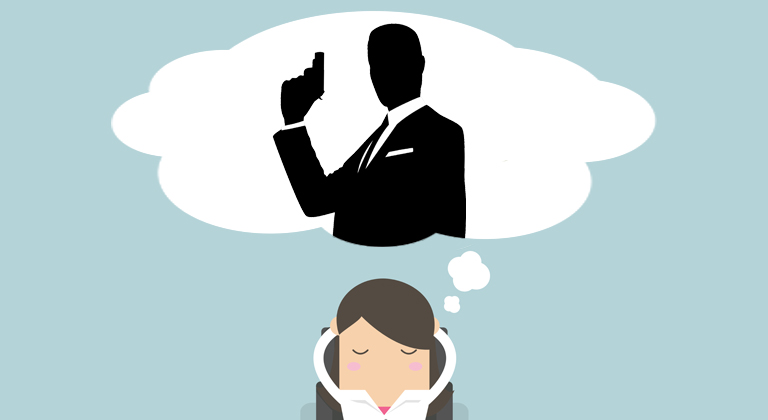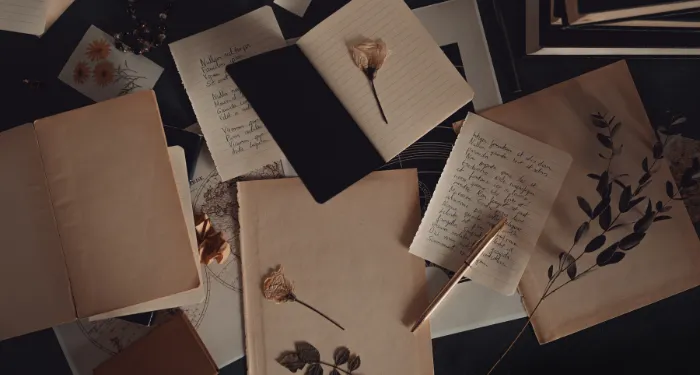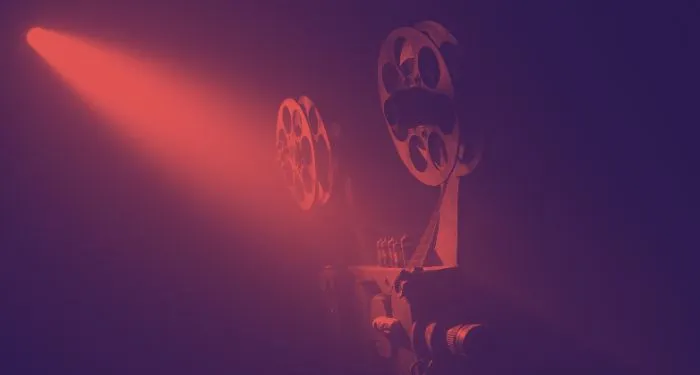In our May 29, 2025, issue, Chris Ware takes a close look at Olivier Schrauwen’s graphic novel Sunday and the formal qualities that make comics uniquely suited to transmitting thought. Ware writes: “In what other medium could one simultaneously inhabit the mind of a character and ‘see’ both his memories and imaginings?”
I first read Ware’s series Acme Novelty Library as a teenager in the early 2000s. At the time I read mostly manga about guys with magic powers beating each other up or pulpier American comics like Batman or Hellboy. I immediately loved the nested intricacy of his page layouts and his unique sense of color, and I felt challenged and surprised by the complex emotional landscapes they were employed to describe.
Last week Ware and I corresponded over e-mail about some questions his essay raised for me.
Will Simpson: Did anything strike you differently when reading the collected edition of Sunday, as opposed to the original serialized risograph format?
Chris Ware: Probably the most obvious difference between the serialized and the book versions is the way the final book feels as an object—a thick, rather authoritative tome versus the slimmer paperback periodicals, or “floppies” as some comic publishers drearily refer to them. Another significant variance between them was the ink colors. Each chapter employs two complementary colors, plus black, with the hues shifting from chapter to chapter. The third chapter was originally printed in blue and yellow, and the book version used a deeper, oranger yellow, which made images printed solely in that color slightly easier to see, but still like a shaky memory quickly passing through one’s consciousness.
For those readers who aren’t familiar with risograph printing, it’s more or less old office-mimeograph printing but with a much zippier palette of candy-colored inks. For those who aren’t familiar with old office-mimeograph printing, you’re probably young enough not even to bother reading this interview.
In your own work—many of the New Yorker covers come to mind—screens seem to lurk everywhere, threatening to overtake life. In Sunday, almost the very first thought Thibault has upon waking up is that he should check his e-mail. Both you and Schrauwen seem drawn to depicting the grotesque or embarrassing possibilities of the digital commons. Do you find that the daily impositions of the Internet can be hard to address in comics in a way that feels right? Do you see your approach as different from Schrauwen’s?
If one is alive right now and, hopefully, trying to write about being alive right now, one can’t not write about the dark digital ponds into which we’re always looking for answers, diversions, and reassurances of our own beauty. Personally, I find it somewhat amusing if not a little thrilling to transpose the iPhone’s ineffability onto good old corporeal ink and paper, as well as to let it leak into the consciousnesses of my characters and their memories in the same way that, well, it does.
Schrauwen much more directly writes about social media and Instagram in Sunday than I have, however. Furthermore, his innovative and extremely smart device of sinewing his entire book around a running stream-of-consciousness text rather than threading it through the traditional series of pictures allows him to more freely cast images into the realm of memory, uncertainty, and prevarication; his “spine” of text, with images growing on either side of it, is such a simple idea but so smart and, perhaps, a more accurate model of how self-awareness might actually work.
I mention Nabokov several times in the review—who was an insistently tactile, visual writer—making drawings and notes not only for his own works but also as aids to understanding fiction by others; he rather famously took James Joyce to task for leaning into language as paramount in memory, opining that we think as much in pictures as in words. When I close my own eyes and try to sort it all out, I can’t ever tell what’s going on. But Schrauwen’s model seems to come closer than anything else.
I detect a lot of (friendly) competitiveness in your review, which seems so true to comics: saying you’re “even envious” of his work, that he finishes more pages, that “we cartoonists steal from one another like rats.” When you’re writing a review, how do you separate your reading of his work from your own involvement in the “living language” of comics?
A lot of those asides were in there not only to amuse the reader but also to (hopefully) amuse Schrauwen. I’m not sure how most citizens view cartoonists, but I don’t think it’s entirely favorably. While we can be antisocial, agoraphobic, and sometimes even just assholes, we also all pay very close attention to what the others are doing and ask each other questions—though largely in our imaginations or on the page itself. As an art student in the 1980s I was regularly told by talentless instructors that “painting was dead” (though the work of one of your other contributors, David Salle, proved the statement wrong, both then and now). The most thoughtful cartoonists I know are trying to expand both the form and the content of their work, making it very much a living language, ever in flux and development. (And so is painting, for that matter.)
In America comics are sometimes set aside as a “special needs” sort of thing, not exactly helped by the puerility of the superheroes grafted onto them during World War II, now metastasized to accommodate heated seats and supersize drink holders. The general cultural acceptance of comics marked by Art Spiegelman’s Maus winning a Pulitzer in 1992 seems to have dried up, and we’re back to comics now being favored as a “gateway to reading,” which is dispiriting, given that in literature the comics language is the only one that asks its reader to be visually literate as well as just plain old literate.
Meanwhile, in Europe, comics seem to be ever more valued. A museum-wide exhibition of the history of comics filled all the floors of the Pompidou last year, with, in some cases, original ink-and-paper comic pages placed alongside examples from their European painting collection—and without apology or explanatory text.
Comics are a complicated ballet of words and images and rhythm and gesture and color and imaginary sound that at their best synesthetically recreate on the page the sensation of life. Schrauwen’s work is a wonderfully eloquent and very contemporary example of exactly this.
You write that “Schrauwen knows that the half-life of an image in comics is exactly the fraction of a second it takes the eye to move to the next one, and he’s not wasting his or anyone’s time.” Is something lost in this approach? Will a reader speed past a lushly drawn panel due to sheer momentum?
As I think I wrote years ago in a review of Philip Guston’s “Poor Richard” for the webpages of this magazine, comics are a language that depends on the reading of pictures, not just looking at them. As such, it uses some of the same cognitive faculties that the reader is using right now to read (and not just see) the words on this page. Thus, in comics, the story eats the pictures; images become as secondary to the experience as do the words—but also: essential. Schrauwen works in animation and is especially sensitive to choosing moments that not only suggest movement but also thwart it, presenting humanity in cosmically embarrassing moments, such as when Thibault dances to James Brown in the first chapter of Sunday.
The tidbit in your piece that “Nabokov was a closet comics fan” reminds me of many similar stories: Gertrude Stein translating Krazy Kat for Picasso; Federico Fellini starting out as a cartoonist and poster illustrator (and later collaborating with Milo Manara, who would cook them omelets laced with powdered amphetamine to stay up working on the comic together); Orson Welles and Alain Resnais being avid fans of Terry and the Pirates (Welles even corresponding with Milton Caniff); John Updike writing fan mail for Little Orphan Annie. Have you experienced this? People reaching out to just contact you or acknowledge your influence?
Wow, I hadn’t heard the omelet story before. I’m not sure if I would’ve continued to draw comics if I hadn’t met Dave Eggers and Zadie Smith and they hadn’t been so kind, respectful, and, especially, encouraging. That they’ve actually read my books and appear not to have thought them utter drivel means the world to me. (A European traveling retrospective of my stuff now ending at the CCCB in Barcelona somehow cajoled Zadie into doing a video interview, and it’s my favorite part of the exhibit.) I’ve also met film directors I greatly admire who must’ve received some sort of tax incentive for being nice to a cartoonist—Todd Solondz, Tamara Jenkins, Alexander Payne, Jim Taylor, Alex Garland, J.J. Abrams—all claiming they thought I had something going on, but in the long run I think I scared them away.
Over the years I’ve seen many cartoonists’ work brazenly thieved by people involved in more fashionable and respected cultural pursuits with zero credit or acknowledgment, suggesting that there’s something in American culture that defines comics as simply free for the taking. It reminds me of getting punched in the head by one of the jocks or jumped in the hallway between the bells. But cartoonists, like vengeance and disease, are patient.
The main point here is that, along with being the publication that at the moment seems especially able to understand and revere thoughtful graphic novelists, The New York Review has a readership that would appreciate Schrauwen’s genuinely literary, funny, and living work perhaps more widely than any other. It was a thrill to be able to write about someone I admire so much for an intelligent and literate audience whom I hope will, as well.
What kinds of non-comics influences find their way into your work? What have you read and enjoyed most recently?
Late to the party, I read all of Knausgaard’s My Struggle in 2024, which was just as companionable, funny, and moving as every review and reader said it was, and it made me pay even closer attention to the world than I thought I already had been, but wasn’t; also, of course, Zadie Smith’s The Fraud and Dave Eggers’s The Eyes and the Impossible and Jonathan Franzen’s Crossroads. Jon Fosse’s Septology, which I found initially annoying and off-putting but about thirty-six hours after putting it down realized was a weirdly vivid masterpiece, taking up residence in my mind in a place I didn’t realize existed and had apparently been until that moment vacant.
Continuing with Norwegians, I read Sigrid Undset’s Kristin Lavransdatter and am now into Russia, only a few pages out from the end of Vasily Grossman’s Stalingrad, all in preparation for his Life and Fate, recommended to me by my friend Joe Sacco (with my thanks to your publishing arm for making these two works available). I greatly prefer, and try to write, books that sprawl and grow and lose track of themselves—just like life itself—and am extremely wary of novels that claim to be “about” something—which is, again, why I love Schrauwen’s Sunday so much.



















 English (US) ·
English (US) ·